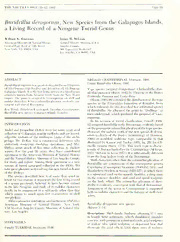
Buridrillia deroyorum, new species from the Galapagos Islands, a living record of a Neogene turrid genus PDF
Preview Buridrillia deroyorum, new species from the Galapagos Islands, a living record of a Neogene turrid genus
— THE NAUTILUS 106(1):39-42. 1992 Page 39 Buridrillia deroyortim. New Species from the Galapagos Islands, a Living Record of a Neogene Turrid Genus William K. Emerson James H. McLean American Museiiiii ol Natural Histor\ Natural Histors Museum of Los Central Park West at 79tl) Street Angeles C^ountv New York, NY 1002-1, USA 900 Exposition Boulevard Los Angeles, C.\ 90007, USA ABSTRACT Subfamily CRASSISPIRINAE Morrison, 1966 Genus Buridrillia Olsson, 1942 Buridrillia(U'riiyiiruninewspeciesisdescribedfrom310meters oft Isla Floreana (l>pe localit> I and365 metersoff Isla Duncan, T\pe species (original designation): Clathrodrilla (Bur- Galapagos Islanils It is the first li\ing speciesof a turrid genus idrillia)panarica Olsson, 1942:51. Plioceneof the Burica otherwise known from Neogene fossils from the New World Peninsula, Panama and Costa Rica. tropics. The genus is assigned to Crassispirinae on shell and Olsson (1964:98) extended the distribution of the type rvaedrugleanrtcwhiatrhactteharts.ofItBhoarssoancioinlauem,ellarplication, evidentK con- species to the Esmeraldas formation of Ecuador, from which sediments healsodescribed five additional species Key M'ords: Prosobranch gastropod; Turridae; Clrassisiiirinae; of Buridrillia. He allocated the genus to "Drillinae" as Buridrillia new species; Galapagos Islands, Ecuador. then understood, which predated the proposal of Cras- sispirinae. In his revision of turrid classification, Powell (1966: INTRODUCTION 62)assignedBuridrilliatotheBorsoniinae,evidentlybased Andre and Jacqueline DeRoy were for many years avid ontheprominentcolumellarplicationofthetypespecies. However, the radular tooth of the new species B. deroij- collectors of Galapagan marine mollusks and are knowl- orum is clearly of the duplex (terminology of Morrison, edgeable students of the molluscan fauna of the archi- pelago. Mr. DeRoy was a commercial fisherman who 1966) or modified wishbone type, comparable to that undertook numerous dredging operations, and Mrs. illustrated by Kantor and Taylor (1991, fig. 2B) for Cli- DeRoy spent much of her time collecting in shallow onclla sinuata (Born, 1778). This tooth type is charac- teristicof(but not limited to)theCrassispirinae(McLean, swapteecrism.enFsortotthhee pAamsetri3c0anyeaMrus,setuhmeyofhaNvaetucroanltrHiibsuttoerdy 1971; McLean in Keen, 1971). It issubstantiallydifferent from the long hollow tooth of the Borsoniinae. and the Natural History Museum of Los Angeles County for study and report. Among these specimens is a nWeew BurSihderlilllcihaaraarceterrsemoitihieLsrcetnhtanofthethceolcurmaeslsilsaprirpilniecagtieonneroaf species of turrid gastropod collected in the 1970s. Ciassispira (Crassispira) Swainson (1840:152, 313), and takegreat pleasure in describing this new turrid in honor Hindsiclava Hertlein & Strong (1955:227), in which there of the DeRoys. The species described here is of more than usual in- oisnatshuebscuotnucraalvecosrhdouolndetrh,easnmdooatxhialshaonulddesrp,iraaldseceuplpstiunrues terest for two reasons: it represents the first living record on the body whorl. The columellar plication of Buri- of a genus previously believed to have become extinct irnesutlhteslianteitNseaosgseingen,meanntdtsotaudsyuobffaitmsirKadoutlhaerrcthhaarancttehrats dbArositslhliigaonnmiserneavdtiudloeafnrttclhhyearcgaoecnntvueesrrsgtaeonnCtdrawtsihsetihsbpatilhraaitnncaoeefoiBfsosrshsueoplnlpioicrnhtaaeer.d- which comes to mind upon first examination of shell acters. morphology. AMNH Abbreviationsforinstitutionsused inthetext: American Museimi of Natural History, New York; Buridrillia deroijonim new species LACM—Los Angeles County Museum of Natural His- (figures 1-14) tory, Los Angeles. mm Description: Shell sturdy, fusiform, attaining 57-1- in length. Spire acuminate, whorls shouldered, shoulder SYSTEMATICS concave,withprominentsubsuturalcords;axialsculpture of nodose ribs; spiral sculpture of depressed lirae that Familv TURRIDAE Swainson, 1840 decussate the axial ribs to form three rows of nodules; Page 40 THE NAUTILUS, Vol. 106, No. 1 Figures 1-14. BuridriUiadcroijorum new.specie.s. 1-3. Holotype, .AMNH 2321ti3; 4-6. I'aratype #8, LACM 2461; 7,8. Paratype #5, AMNH 232165 (Kigure.s l-«, slightly reduced, seeTable 1 for measurements). 9, 10. Paratype #8, LACM 2461,spireenlarged about X 2.5. 11, 12. Paratype #10, Operculum, 11. View of interiorside, 12. View of exterior side (Figures 11, 12, about X 2.5). 13, ll-. Paratype #12, Raciuiar (icnlitinn (Scale bar for 1:3 = lOO^m, for 14 = .W^jin). body whorl with numerousspiral lirae that interrupt the (Figures9, 10); bod\ whorl sculptured with 12to 13axial axial sculpture on the anterior half. Protoconch lost on ribs. Aperture large, outer lip thin, inflated, explaned 14 of the 15 specimens, protoconch poorly preserved on with a deep, L'-shaped anterior notch, posterior notch paratype#8(Table 1), of2 1/2apparently smooth whorls deep, widely open; columella with a prominent plication W K. Emerson and H McLean. 1992 Page 41 J. Table 1. Buridrillia dcroijorum new species. Shell measure- ments in mm. Spires not preser\'ed, except for parat\pe #8. Number of specimens examined = 15 Page 42 THE NAUTILUS, Vol. 106, No. 1 W Morrison,J, P E. 1966, OnthehiMiilii-sol Turridae, American Powell, A, B 1966, The moliuscan families Speightiidae Malacological L'nioii, Annual Reports, tor 1965:1-2, and Turridae Bulletin of the .Aucklanil Institute and Mu- Olsson, .'\. .\. 1942, Tertiars atitl (Quaternary fossils from the seum. 5:184 p., 23 pis, Buriea Peninsula of Panama and Costa Hiea Bulletins oi Swainsou, W, 1840, .\ Treatiseon Malacology or the Natural Amerieau Paleoiitolog) 27(106):1-106, C;lassification of Shells and Shell-fish, London, 419 p. Olsson, A. ,\, 1964, Neogene moiiusks Irom northwestern Ecuador, Paleoiitological Research Institution, Ithaca. New York, 256 p,, 38 pis.
